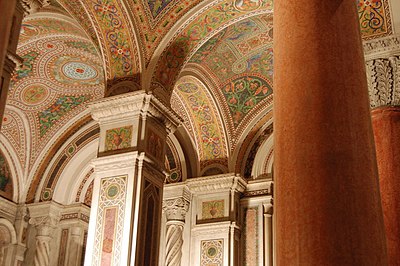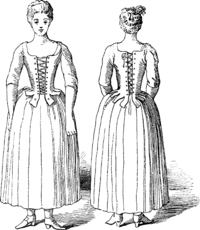Design: Difference between revisions
m →Defining a design process: from plural to possesive |
→Philosophies for the purpose of designs: Added paragraphs. |
||
| Line 24: | Line 24: | ||
===Philosophies for the purpose of designs=== |
===Philosophies for the purpose of designs=== |
||
In [[philosophy]], the abstract noun "design" refers to pattern |
In [[philosophy]], the abstract noun "design" refers to a pattern with a [[purpose]]. Design is thus contrasted with purposelessness, [[randomness]], or lack of [[complexity]]. |
||
To study the purpose of designs beyond simple [[marketing]] goals is to question [[morals]], [[ethics]] and [[need]]s such as [[Maslow's hierarchy of needs]]. "Purpose" may also lead to [[existential]] questions such as [[religion|religious morals]] and [[teleology]]. These philosophies for the purpose ''of'' designs are in contrast to philosophies ''for'' designs, which are questions of methodology. |
|||
A [[designer]] may not be in a position to define purpose and, in many cases, need not be concerned with purpose or intended use beyond what the designer has control over. |
|||
===Philosophies for methods of designing=== |
===Philosophies for methods of designing=== |
||
Revision as of 06:21, 11 January 2007




Design, usually considered in the context of the applied arts, engineering, architecture, and other such creative endeavours, is used as both a noun and a verb. "Design(ing)" as a verb refers to the process of originating and developing a plan for a new object (machine, building, product, etc.). As a noun, "design(s)" is used both for the final plan or proposal (a drawing, model, or other description), or the result of implementing that plan or proposal (the object produced).
Designing normally requires considering aesthetic, functional, and many other aspects of an object, which usually requires considerable research, thought, modeling, interactive adjustment, and re-design.
Philosophies of design
A design philosophy is a guide to help make choices when designing. An example of design philosophy is “dynamic change” to achieve the elegant or stylish look you need.
Some popular types include:
- Use-centered design, which focuses on how it will be used, often involving the end user early on.
- User centered design, which focuses on the needs, wants, and limitations of the end user of the designed artifact
- Task-centered design. The process is structured around specific tasks that the user will want to accomplish with the product or service being developed.
- KISS principle, (Keep it Simple, Stupid), which strives to eliminate unnecessary complications
- TMTOWTDI (There's More than One Way To Do it), Perl's design philosophy to allow multiple methods of doing the same thing
- Form Follows Function
- Measure Twice, Cut once (and its IT addendum: Save three times)
- Murphy's Law (Everything that can go wrong will, so plan for it before hand)
Philosophies for the purpose of designs
In philosophy, the abstract noun "design" refers to a pattern with a purpose. Design is thus contrasted with purposelessness, randomness, or lack of complexity.
To study the purpose of designs beyond simple marketing goals is to question morals, ethics and needs such as Maslow's hierarchy of needs. "Purpose" may also lead to existential questions such as religious morals and teleology. These philosophies for the purpose of designs are in contrast to philosophies for designs, which are questions of methodology.
A designer may not be in a position to define purpose and, in many cases, need not be concerned with purpose or intended use beyond what the designer has control over.
Philosophies for methods of designing
Design Methods is a broad area that focuses on:
- Exploring possibilities and constraints by focusing critical thinking skills to research and define problem spaces for existing products or services—or the creation of new categories; (see also Design thinking)
- Redefining the specifications of design solutions which can lead to better guidelines for traditional design activities (graphic, industrial, architectural, etc.);
- Managing the process of exploring, defining, creating artifacts continually over time
- Prototyping possible scenarios, or solutions that incrementally or significantly improve the inherited situation
Design as a process
Design as a process can take many forms depending on the object being designed and the individual or individuals participating.
Defining a design process
According to video game developer Dino Dini in a talk given at the 2005 Game Design and Technology Workshop held by Liverpool JM University, design underpins every form of creation from objects such as chairs to the way we plan and execute our lives. For this reason it is useful to seek out some common structure that can be applied to any kind of design, whether this be for video games, consumer products or one's own personal life.
For such an important concept, the question "What is Design?" appears to yield answers with limited usefulness. Milan is where many people hope their fashion will tour. Dino Dini states that the design process can be defined as "The management of constraints". He identifies two kinds of constraint, negotiable and non-negotiable. The first step in the design process is the identification, classification and selection of constraints. The process of design then proceeds from here by manipulating design variables so as to satisfy the non-negotiable constraints and optimising those which are negotiable. It is possible for a set of non-negotiable constraints to be in conflict resulting in a design with no solution; in this case the non-negotiable constraints must be revised. For example, take the design of a chair. A chair must support a certain weight to be useful, and this is a non-negotiable constraint. The cost of producing the chair might be another. The choice of materials and the aesthetic qualities of the chair might be negotiable.
Dino Dini theorises that poor designs occur as a result of mismanaged constraints, something he claims can be seen in the way the video game industry makes "Must be Fun" a negotiable constraint where he believes it should be non-negotiable.
It should be noted that "the management of constraints" may not include the whole of what is involved in "constraint management" as defined in the context of a broader theory of constraints, depending on the scope of a design or a designer's position.
Typical steps
A design process may included a series of steps followed by designers. Depending on the product or service, some of these stages may be irrelevant, ignored in real-world situations in order to save time, reduce cost, or because they may be redundant in the situation.
Typical stages of the design process include:
- Pre-production design
- Design brief - a statement of design goals
- Analysis - analysis of current design goals
- Research - investigating similar design solutions in the field or related topics
- Specifications - specific requirements of a design solution
- Presentation - presenting of a design solutions
- Design during production
- Development - continuation and improvement a designed solution
- Testing - in-situ testing a designed solution
- Post-Production design feedback for future designs
- Implementation - introducing the designed solution into the environment
- Evaluations and conclusions - summary of process and results, including constructive criticism and suggestions for future improvements
Terminology
The word "design" is often considered ambiguous depending on the application.
Design versus art
Design is often viewed as a more rigorous form of art, or art with a clearly defined purpose. The distinction is usually made when someone other than the artist is defining the purpose. In graphic arts the distinction is often made between fine art and commercial art.
In the realm of the arts, design is more relevant to the "applied" arts, such as architecture and product design. Design implies a conscious effort to create something that is both functional and aesthetically pleasing. For example, a graphic artist may design an advertisement poster. This person's job is to communicate the advertisement message (functional aspect) and to make it look good (aesthetically pleasing). The distinction between pure and applied arts is not completely clear, but one may consider Jackson Pollock's (often criticized as "splatter") paintings as an example of pure art. One may assume his art does not convey a message based on the obvious differences between an advertisement poster and the mere possibility of an abstract message of a Jackson Pollock painting. One may speculate that Pollock, when painting, worked more intuitively than would a graphic artist consciously designing a poster.
Design versus engineering
Engineering is often viewed as a more rigorous form of design. Contrary views suggest that design is a component of engineering aside from production and other operations which utilized engineering. A neutral view may suggest that both design and engineering simply overlap, depending on the discipline of design. The American Heritage Dictionary defines design as: "To conceive or fashion in the mind; invent," and "To formulate a plan", and defines engineering as: "The application of scientific and mathematical principles to practical ends such as the design, manufacture, and operation of efficient and economical structures, machines, processes, and systems." [1][2]. Both are forms of problem-solving with a defined distinction being the application of "scientific and mathematical principles". How much science is a applied in a design is a question of what is considered "science".
Design versus production

The relationship between design and production is one of planning and executing. In theory, the plan should anticipate and compensate for potential problems in the execution process. Design involves problem-solving and creativity. In contrast, production involves a routine or pre-planned process. A design may also be a mere plan that does not include a production or an engineering process, although a working knowledge of such processes is usually expected of designers. In some cases, it may be unnecessary and/or impractical to expect a designer with a broad multidisciplinary knowledge required for such designs to also have a detailed knowledge of how to produce the product.
Design and production are intertwined in many creative professional careers, meaning problem-solving is part of execution and the reverse. As the cost of rearrangement increases, the need for separating design from production increases as well. For example, a high-budget project, like a skyscraper, requires separating (design) architecture from (production) construction. A Low-budget project, like a locally printed office party invitation flyer, can be rearranged and printed dozens of times at the low cost of a few sheets of paper, a few drops of ink, and less than one hour's pay of a desktop publisher.
This is not to say that production never involves problem-solving or creativity, nor design always involves creativity. Designs are rarely perfect and are sometimes repetitive. The imperfection of a design may task a production position (e.g. production artist, construction worker) with utilizing creativity or problem-solving skills to compensate for what was overlooked in the design process. Likewise, a design may be a simple repetition (copy) of a known preexisting solution, requiring minimal, if any, creativity or problem-solving skills from the designer.
See also
Footnotes
- ^ American Psychological Association (APA): design. (n.d.). The American Heritage® Dictionary of the English Language, Fourth Edition. Retrieved January 10, 2007, from Dictionary.com website: http://dictionary.reference.com/browse/design
- ^ American Psychological Association (APA): engineering. (n.d.). The American Heritage® Dictionary of the English Language, Fourth Edition. Retrieved January 10, 2007, from Dictionary.com website: http://dictionary.reference.com/browse/engineering
- ^ Concerns the existence and construction of mathematical set systems that have specified numerical properties.
- ^ Drafting and other forms of modelling.
- ^ Examines the role of embedded behaviour in human environments.
- ^ Actively involving users in the design process.
- ^ Includes economic, environmental and political issues.
